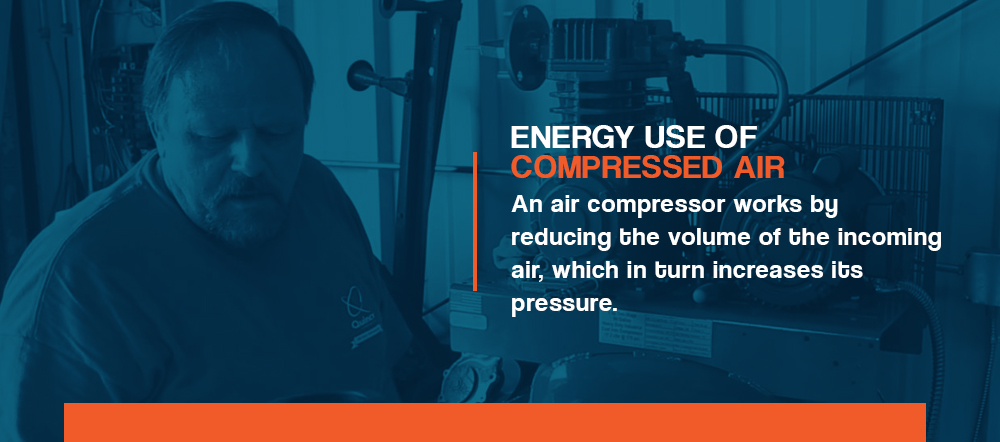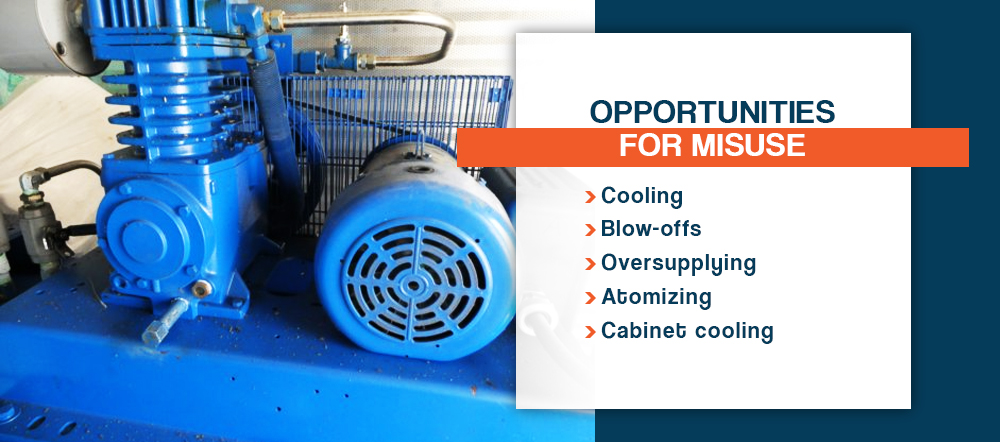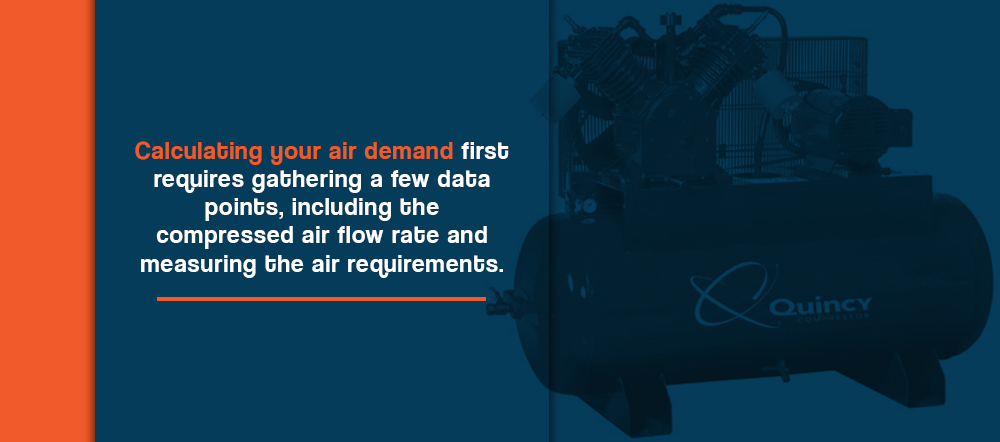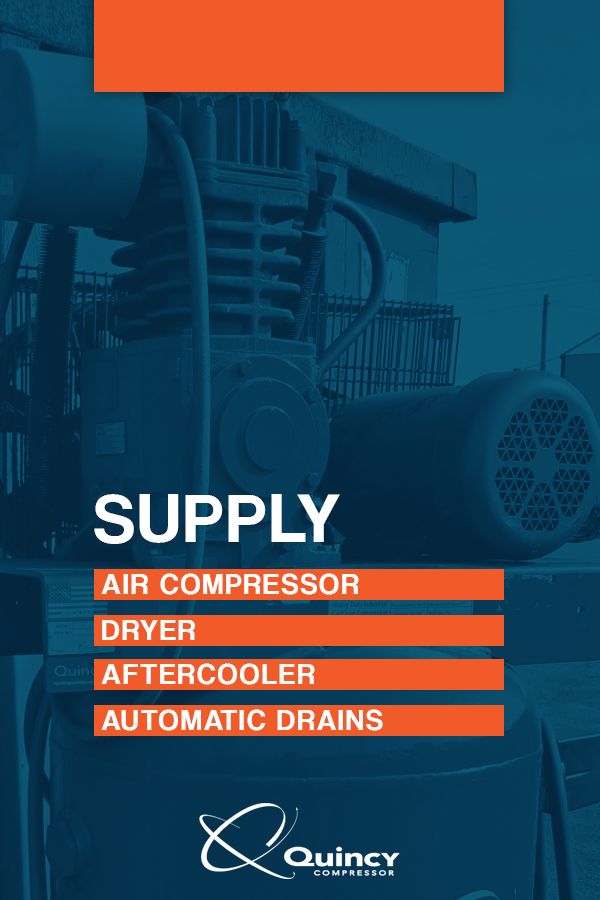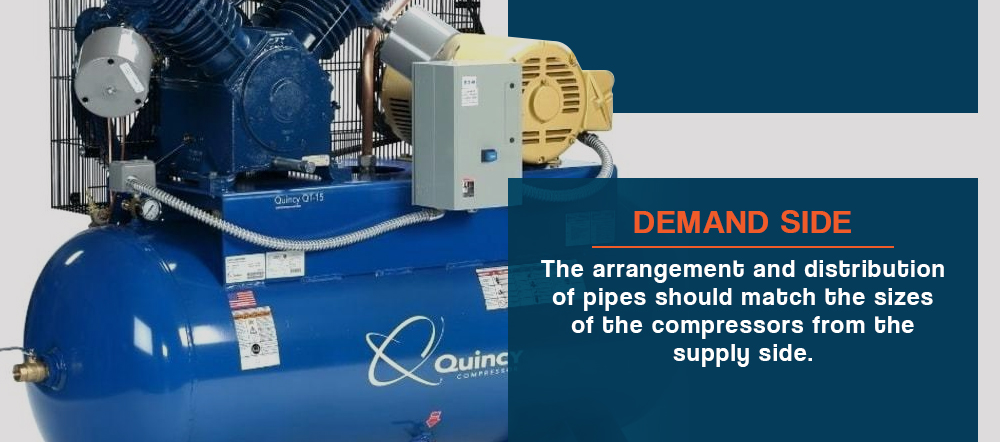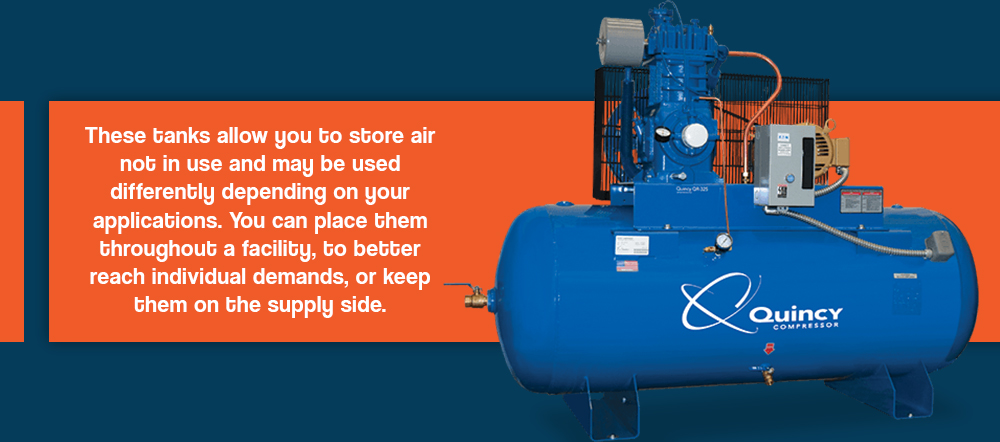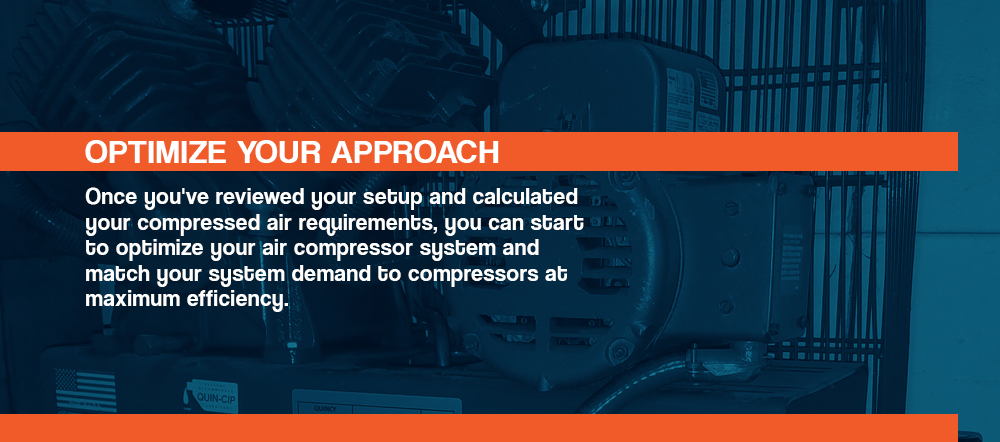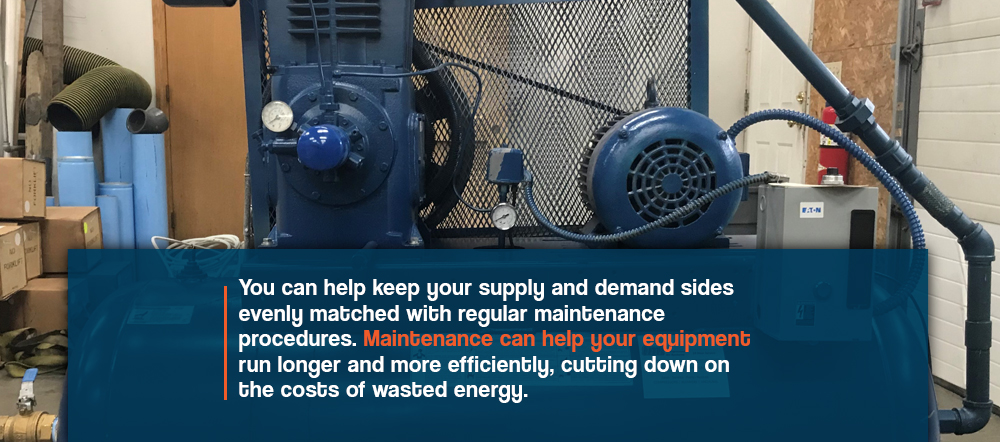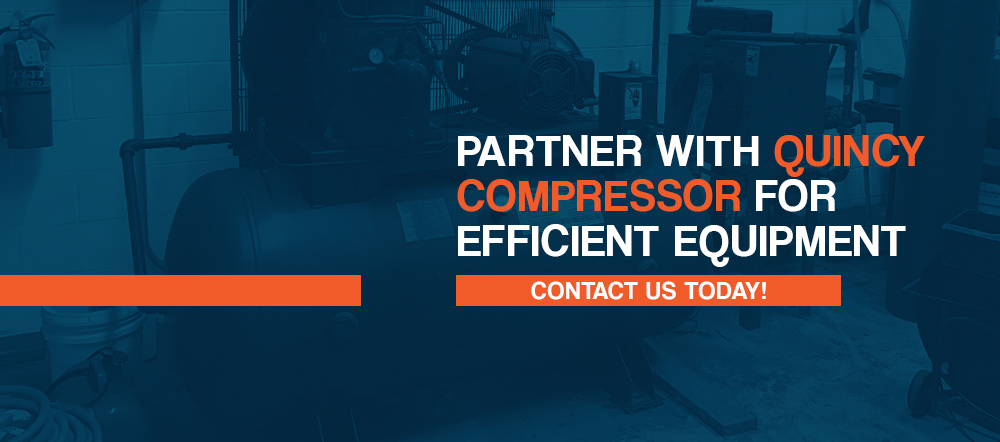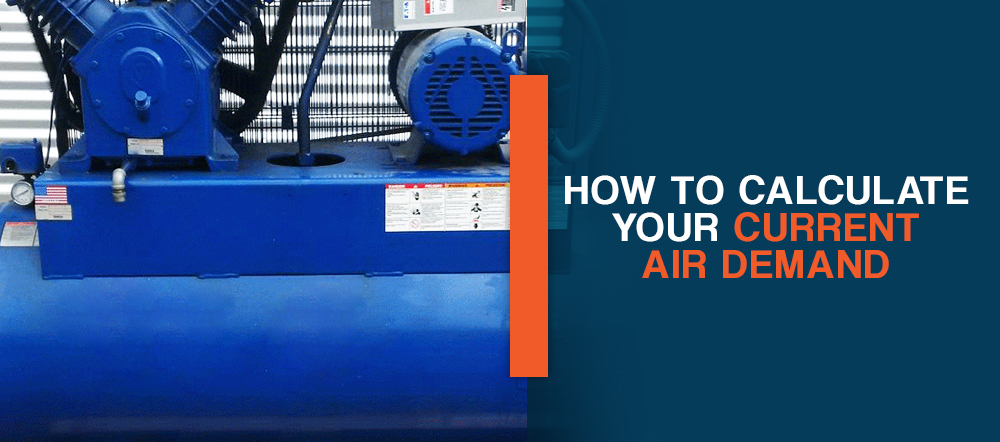
Any industry that uses compressed air is subject to inefficiency. This is because air compressors inherently consume a lot of energy just to produce the air, and once produced, employees tend to misuse it. It’s easy to fall into the trap of feeling like compressed air is free, but unfortunately, as anyone reviewing your electricity bill can tell you, that’s not the case. Calculating your air demand and appropriately adjusting your operating procedures is a critical component to minimizing wasted air and making your entire process more efficient.
We’ll go over several components of compressed air, including the inefficiencies within production, opportunities for misuse, calculating demand and supply, estimating compressed air consumption and more factors that can help you measure and optimize your air usage.
Energy Use of Compressed Air
Before we get into the nitty-gritty of calculations and optimization, let’s take a moment and go over the process by which compressed air is produced.
An air compressor works by reducing the volume of the incoming air, which in turn increases its pressure. Usually, a positive displacement pump, such as a centrifugal impeller or rotary screw, is used to reduce the volume of air. This action occurs with the help of an electric motor. Once compressed, the air is transported through the system to its end-use, though pressure losses can happen as the air moves through the piping.
So we know this process consumes a lot of energy, but where does it all go?
- Much of it goes to cooling the air. As the motor runs, it inadvertently heats the compressed air, which then needs cooling. This cooling can be done with a fan and water- or air-cooled heat exchanger. These tools, of course, require more energy
- Some of it, of course, goes to powering the motor.
- Another chunk of energy is lost on waste and leakage, including that which occurs from inappropriate usage.
- Whatever is left over goes to productive use. Approximately 15 percent of the energy that goes into an air compressor offers productive, efficient use.
Since the process of compressing air in the first place consumes so much energy, it makes conserving it that much more critical. Just a 10 percent improvement over current usage could result in saving about three billion kilowatt-hours of electricity nationwide.
Opportunities for Misuse
Many people tend to think that compressed air is an unlimited resource and try to use it for a variety of tasks that they could complete more efficiently with different tools. Using compressed air for something it wasn’t intended for makes the system more inefficient and costs extra resources and money. To cut down on these problems, you’ll want to identify any areas where misuse may occur. These tasks may include:
- Cooling: In hot facilities or during difficult summer months, workers might attempt to use compressed air to cool down. They may turn the output onto themselves or create several holes in a pipe to do the job. The rule of thumb for compressed air leaks is that a hole of 1/8 of an inch in a 100-psi air line costs about $1,000 a year in electricity. If an employee makes several holes to create a makeshift fan, that can add up. Compare this number to the $149 a year it would cost to run an electric fan, and you can see how personal cooling with compressed air can hurt your bottom line.
- Blow-offs: You may find air compressors used for cleaning purposes in what is called a “blow-off.” During a blow-off, compressed air is blasted onto a surface to remove moisture, dirt and debris. While it might do that job, a more efficient option would be to use a low-pressure blower designed explicitly for that purpose. This kind of blower should conform to health and safety standards and be properly regulated.
- Oversupplying: Using more air than necessary adds significant demand to your air supply system. Reviewing machine requirements can help you more accurately gauge the needed pressure and optimize the supply amounts.
- Atomizing: Atomizing involves using compressed air to disperse a liquid into a process as an aerosol, such as putting fuel into a boiler. If the pressure fluctuates, combustion efficiency can change. Low-pressure blowers are usually a suitable alternative.
- Cabinet cooling: Cabinet cooling is common to address heating from programmable controllers, numerical control systems, line control cabinets, computer control cabinets and more. Other forms of cooling besides compressed air are usually more effective for cabinet cooling.
Any kind of inappropriate use creates an artificial demand, pulling from the real sources that need to use the supply. Eliminate them wherever possible. For every 2 psi increase in discharge pressure, the consumption of energy increases by about one percent at full output flow. It also increases the demand for inappropriate usage, like leaks and open blowing. Unregulated usage can make up 30-50 percent of a plant’s air demand, and that same 2 psi increase will add 0.6-1 percent to the energy demand. Combining the effects adds about two percent to the energy consumption for every increase of 2 psi in a system with a 100 psig range and within 30-50 percent of unregulated air usage. For applications with high demands, sometimes a modification to the equipment can save energy, as opposed to raising the entire system’s pressure.
Reducing system pressure affects many factors, including leakage rates, capacity and equipment stress, but may require modifications to some components such as pressure regulators and filters. Of course, you still need to stay above minimum requirements to keep equipment running appropriately, but an audit of this requirement and the actual demand for pressure can reveal any unnecessary use.
How to Calculate Your Air Demand
Calculating your air demand first requires gathering a few data points, including the compressed air flow rate and measuring the air requirements. How do you calculate compressed air requirements? There are several different methods and tools you can use based on your needs and your system. Some require more expensive tools or services than others, and some offer more accurate or long-term results.
One piece of information you’ll need to find is the load profile of your system.
- Method #1: This approach offers a fast estimate of compressor capacity and the system’s demand, but it is less accurate than some of the other methods. It involves timing the compressor’s load and unload cycles and taking note of the receiver volume and load and unload pressures.
- Method #2: This second method is typically more accurate and requires the help of a professional. The professional attaches a data logger to the system for a set amount of time, such as a week or two. In that time, it gathers data about the current, its trends and any fluctuations that occur.
- Method #3: This option gives you long-term data, collected over a long period, that is more accurate. It involves using an inline flow metering tool that logs data electronically. You can catalog this information and use it for extended, continuous monitoring and adjustments.
Another valuable data point is your system’s compressed air consumption. There are a few different factors that go into how you calculate compressed air consumption, which is based on the volume of air used per unit of time. This flow rate can be measured in cubic feet per minute (CFM). CFM, however, can vary widely and become a source of misunderstanding. Air is compressible and changes rapidly due to atmospheric variation of air pressure, density, temperature and more. Location, altitude and seasons can all affect different conditions of air.
Because of the capacity for misunderstanding, a few different variations on CFM are used:
- Standard CFM (SCFM): To adjust for the differences in pressure in different conditions, SCFM adjusts a standard cubic foot of air to fill one cubic foot of volume. It measures weight, not volume. It adjusts for pressure per square inch absolute (psia), temperature and relative humidity.
- Actual CFM (ACFM): ACFM rates the flow performance with the actual pressure and temperature.
- Inlet CFM (ICFM): ICFM refers to the conditions that should be present at the inlet flange of the compressor. Typically, an inlet filter causes air pressure to drop when air is pulled through, and compressor vendors need to account for this to accurately estimate performance.
Finally, you’ll need to conduct an operating analysis, which allows you to find the optimal level of compressed air you should produce. You can find the air consumption data for all of your machines and their expected utilization factors. Measure these over an appropriate period, at least a week, during normal operating procedures that are representative of your typical habits. Standard values are available if you can’t find this information, but it’s always better to get exact numbers from your equipment. These can tell you about the accuracy of load estimates in order to size equipment and tell how much reserve capacity a system has.
You will need to consider several factors of machine operation, such as:
- How long it is operated
- How often it is used
- How much pressure it receives
- How many machines are in use
- Loading and off-loading times
To find the amount of air needed, we’ll start by making a demand profile. List the demands of your machinery based on the manufacturer specifications. This information should include the required pressure and operating flow rates and peak and average conditions. Intermittent demands are also useful to have. Jot down the number of shifts and variations, along with the purpose of the air. Is it for an industrial process, heating, breathing air or something else? This profile helps you make further calculations and make assessments of your facility and operation.
Once you’ve found all of your values, you can plug them into the following calculation, provided by the United States Department of Energy, to find your annual electricity costs.
- (Motor full-load bhp) x (.746 kW/hp) x (1/0.9 motor efficiency) x (Annual hours of operation) x (Electricity cost in $/kWh)
This equation assumes the compressor is 90 percent efficient, which you can adjust at the .9 input. For a 100-hp compressor operating continuously at an electricity cost of $.05/kWh, the annual electricity costs would be $36,305.
Demand and Supply
Compressed air supply and demand refer to the two sides of a compressed air system and influence many different aspects of its efficiency. Understanding the components of both sides will help you identify improvements and inefficiencies in the process and match the supply and demand levels. Let’s look at the supply side first.
1. Supply
Within the supply side, we can look at the air compressor, the dryer, the aftercooler and automatic drains.
- Air compressor: Check out where the compressor is installed, how it is ventilated and how it connects to cooling water. This aspect is of particular concern when compressors are in poorly ventilated areas, like boiler rooms. The air the compressor takes in should come from a cool area outside. A north-facing wall usually works well because it does not see as much direct sunlight, but this can vary based on your facility’s configuration. You will also want to prevent any rainwater or debris, such as leaves and snow, from blocking or entering the inlet.
- Dryer: To review a dryer’s performance, measure its size, efficiency and pressure drop concerning the system’s current use. Some suggest adding a filter upstream of the air dryer, so any particulates or condensation cannot enter it. For a regenerative-desiccant dryer, a coalescing filter can also help reduce contamination at the desiccant bed.
- Aftercooler: Aftercoolers can only handle a certain amount of condensation, so rising humidity levels might make them work harder and reduce their effectiveness.
- Automatic drains: Make sure your drains are working correctly and are at effective locations.
2. Demand Side
Though the demand side has fewer components, it can be more complicated. This side is all about the piping distribution system, which can be a significant source of leaks and inefficiencies if it is not well-designed and maintained.
The arrangement and distribution of pipes should match the sizes of the compressors from the supply side. While leaks are a significant concern, other factors that can cause problems include:
- Sharp angles
- Moisture
- Obstructions and blockage
These aspects can reduce pressure, clog pipes, contaminate the air and restrict airflow. It is essential that your compressed air system’s piping is distributed efficiently. In general, the shorter distance the air has to travel, the less the pressure is likely to drop. The condensate removal system is another valuable aspect that should be as efficient as possible. Slope the main compressed air headers slightly, and give them a pitch of an inch per ten feet of pipe, so water and condensate can drain. Place the drains at low points on the header. To keep moisture out of the use application, branching pipes should go at the top of the header pipe.
Other aspects to watch out for on the demand side are:
- Air treatments: Filtering and drying the air can help keep it at optimal levels, which vary according to your use and application. Measure air quality levels across several crucial points in the system. Besides reducing efficiency, air with excessive moisture or contaminants can damage equipment and prevent the system from running as needed, so you must address it.
- Load profile: The air load profile measures how much the demand for air changes over time in cubic feet per minute. Better methods of control may help if your facility has a load profile that varies throughout the day, while storage options can help facilities with inconsistent but heavy demands.
3. Storage
Looking beyond supply and demand, you will also need storage tanks. These tanks allow you to store air not in use and may be used differently depending on your applications. You can place them throughout a facility, to better reach individual demands, or keep them on the supply side.
Optimize Your Approach
Once you’ve reviewed your setup and calculated your compressed air requirements, you can start to optimize your air compressor system and match your system demand to compressors at maximum efficiency. With this method, you can reduce the amount of power your compressors use. To accomplish this, multiple compressor sequencing may come in handy. Multiple compressor sequencing can include cascading systems and smart sequencing.
- Cascading system: This system overlaps the pressure settings in the installed compressors, causing the appropriate compressor to stop or start according to any change in pressure. If pressure falls below a specific threshold, more compressors start up, beginning with the ones with the highest horsepower. These power on in a tiered system, with compressors turning on at different pressure levels. One may start at 120 psig, the next at 110 psig, the next at 100 psig and so on. If the capacity becomes higher than the demand, the system will shut off the most recently powered-on compressor. The system pressure will need to be slightly higher than the threshold pressure specified for the compressor to power on. Usually, this method works well in facilities with large pressure requirements and bands.
- Smart sequencing: Smart sequence programmable logic controllers provide a more high-tech and highly efficient approach to air compressor systems. These controllers can find the most efficient configuration of compressors and load capacities to successfully meet the needs of a plant. They keep track of pressure and demand while factoring in additional equipment such as dryers. As a facility grows, they tend to meet their requirements by adding air compressors of all types and sizes. This mismatching can decrease efficiency, but a smart-sequencing approach attempts to reconcile that by adjusting factors like which compressors are online and the load at which they operate. Advanced smart sequence controllers can even control multiple systems in different facilities.
In addition to optimizing your controller settings, you can also minimize those wasteful air leaks by performing a thorough test to find them. They can be detrimental to your demand for air and your energy costs, and you should fix them right away. If you hear any hissing, that is a sure sign that leaks are present. They are particularly prevalent at threaded pipe fittings, valve stems, hoses and fittings and drains that have gotten stuck in the open position.
A leak search, tag and repair program is an excellent approach to keeping leaks at bay. This program should find a baseline, compare results and identify leaks for appropriate repair. You could even reward or recognize employees who find leaks. Unfortunately, most air leaks are inaudible. Ultrasonic leak detection can help you find these issues, whether a third-party expert performs it or you do it in-house.
Maintenance
You can help keep your supply and demand sides evenly matched with regular maintenance procedures. Maintenance can help your equipment run longer and more efficiently, cutting down on the costs of wasted energy. Of course, it also prevents the losses incurred during a breakdown or downtime.
Be sure to check the following features of your compressed air system to keep it running smoothly.
- Filters: Replace your air compressor filters regularly to keep pressure and air quality high.
- Condensate drains: If you have condensate drains that are not zero-loss drains, be sure to check on them and make sure they are working correctly. Zero-loss drains can help prevent air from leaving every time it collects moisture.
- Motor and air-end bearings: Ensure that bearings are lubricated and in place.
- Controls: Check that your air compressor’s sequencing and operation match the air demand profile you’ve created.
- Air/oil separator: Clean the separator regularly to prevent drops in pressure.
- Heat exchangers and coolers: Clean the heat exchangers and coolers periodically as well.
Partner With Quincy Compressor for Efficient Equipment
As you can see, air compressors can be highly sensitive to changes within the system. One alteration in pipe design or unregulated use can significantly influence your compressed air system demand. You must monitor this information across your facility to keep energy expenses down and efficiency up.
Older compressors or those with low-quality construction may see issues as they age or require more robust maintenance procedures. If you find that you need to improve your compressed air system or cut energy costs, Quincy Compressor is there for you with unmatched quality and service. Facilities have turned to us for almost a century now for our reliable and efficient equipment. In addition to efficient air compressors, we also offer data logging tools to help you stay on top of your energy consumption and compressor use. For more information about either one, find a Quincy representative near you or browse our selection of products today.


